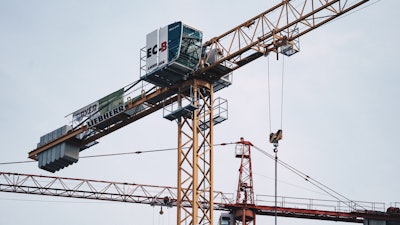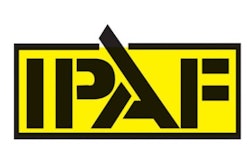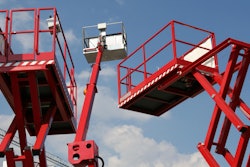
Not many people have a death wish, most just need to get the job done, and using a MEWP can be the safest and most efficient method of doing so. Climb in, elevate, do the job, get down and go home. Right?
Sadly, real life doesn’t always follow the script, and in fact, sometimes it ends in heartbreak with sirens and tears. Accidents occur when using MEWPs because working at height is inherently risky business, but many can be prevented.
Fatal accidents involving MEWPs are statistically very low, with less than .2% of all USA workplace fatalities occurring when using a MEWP.
Accidents repeat, with the same types of incidents happening again and again... climbing out of the platform, not keeping safe distance from power lines, being struck by passing trucks or buses, overturning the machine on inadequate ground are just a few of the most common scenarios. Notably, the rate of fatal accidents involving MEWPs is far higher in North America than in Europe.
Understanding when and where accidents occur helps drive safer work practices, inform supervisors on the risks of the job and aids the selection of the right MEWP.
From accident analysis we can improve training and identify where there are heightened risks.
Since 2012, IPAF and its member companies have worked together to report accident data. IPAF conducts an ongoing project to analyze each reported accident and share conclusions with the industry. This project has resulted in significant improvements, with dedicated training for delivery drivers and supervisors, plus global campaigns to highlight recurring accidents.
Three workers were installing gutters on a three-story residential construction site. A 42-year-old man was working in a 45-foot articulating boom lift, and nearby were his workmates in the basket of a telehandler and a 66-foot straight stick boom lift. The knuckle boom contacted an 8,000-volt power line and the operator was electrocuted. Electricity flowed through the gutter, causing his workmates to be shocked and hospitatlized as a result.
Electrocutions remain leading cause of death
Electrocution is a leading cause of death in the workplace. It is the 6th most common cause of all worker fatalities in US. It is also a common fatality when working at height in a MEWP, with 20% of all reported fatalities due to electrocutions. Working from or moving a MEWP in the vicinity of overhead lines can be extremely dangerous.
Only 30% of all electrocutions are sustained by linesmen or telecommunications specialists, so the majority of these accidents are operators of MEWPs engaged in non-electrical work. Is this due to a lack of training on how to work near power lines?
Or is it a lack of awareness of the safe MAD ( minimum approach distance) and stand-off distance when positioning the machine?
The safest practice is to remove the risk by arranging for power lines to be de-energized and tagged before starting the work. The attitude that “it’s a quick job so I will just keep my distance” can be fatal.
All overhead lines and other electrical apparatus should be treated as live unless declared “isolated” and “safe” by the electric company. If “isolated” and “safe” is not an option, use a specialized insulated aerial device (IAD) MEWP, which are specifically designed for work near and on electrical hazards. Selecting the right MEWP for the task is crucial if operating near live power lines.
At all times, operators must ensure the platform and boom are kept at a safe distance from power lines.
Two telephone line workers were using a truck mount near an overhead power line. One was stationed on the ground, acting as a spotter. The boom was elevated and at some point made contact with the energized line. Electrical current then ran down the boom and through the spotter, resulting in his death.
Don’t fall!
Falls from height are one of OSHA’s infamous Fatal Four – the four most common types of fatal accidents. Within the construction industry it is falls that cause most workplace deaths. Electrocutions, being hit by an object and being crushed or trapped round out the Fatal Four.
Fall protection requirements have been OSHA’s most frequently cited safety violation for eight consecutive years. Training requirements for fall protection are also cited in the top 10. Inadequate fall protection is a planning failure, while insufficient training indicates a failure of management to ensure that all workers can do their job.
MEWPs are designed to improve working at height by providing a safe and stable platform, and so represent the solution to reduce this high rate of accidents. But these machines need to be used safely, and sadly, falls from the MEWP platform are a frequent occurrence. Over the past six years, falls from the platform account for 30% of all fatalities using MEWPs.
To better understand the causes of these falls from MEWPs, IPAF analyzed the accident history. Planning and supervision were identified as the key ways to ensure safety.
Every work task needs a plan, even if it resides in your head. Once you are elevated in a work platform, it’s too late to consider if there is sufficient sign-posting for traffic management, or if the ground has the capacity for the MEWP.
Ever seen someone climb up on the guardrails just to reach that little bit further? Is that a failure of planning to select the right MEWP for the job?
Included in an adequate plan is the selection of a suitable MEWP, risk assessment and consideration of ground conditions, traffic management for vehicles, mobile machinery and cranes, and a rescue plan if there is an accident or machine breakdown.
Exiting the MEWP at height exposes a worker to a higher risk of falling. The guardrails are the primary fall protection, and any slip or trip is a literal dance with death. Unfortunately, many job sites see scissor lifts and boom lifts as an easy way to climb onto roofs or other structures. Planning to exit the MEWP platform is a plan to shortcut the fall protection and to put people at risk.
An electrician was installing electrical service along the perimeter of a commercial freezer working from an electrical scissor lift. There were three people in the platform when the electrician exited the scissor lift to access the top of the freezer. He fell approximately 25 feet to the concrete floor below and was killed.
If supervisors don’t understand the risks of using MEWPs, how can they adequately ensure the team has a safe working practice? The behavior of the workers in the platform has been identified as an initiator for many accidents. Behavior such as climbing on guardrails, tying the entry gate open, leaning or stretching outside of the platform exposes the worker to the risk of falling.
Likewise, not connecting the lanyard or not wearing a harness in boom lifts and truck mounts exposes the platform occupant to being ejected from the platform. The boom extending structure can jolt and vibrate if travelling over rough terrain, over an obstacle or if struck by a vehicle. This can be sufficient to catapult a person out of the lift. A full-body harness and lanyard are critical protection against ejection from the platform.
Falls from height don’t occur only when working at heights over 100 feet. Due to the high rate of accidents from low heights, ladders are now being replaced by low-level access lifts. These push-around and self-propelled smaller MEWPs provide tremendous flexibility and accessibility for worksites and commercial areas, with the benefit of a safe and stable working platform.
Simple actions coupled with planning and training can prevent the majority of falls from MEWPs. Remain in the platform and stay clipped in when using boom lifts and truck mounts.
Working on roads
IPAF has recently launched a new campaign - STREET SMART. This addresses the high risk of operating on or alongside roads. Trucks and MEWP platforms do not mix.
MEWPs are commonly positioned on the side of the road without signage or segregation from vehicles. Even where the chassis is off road, the extending structure and platform can still be exposed in the elevated configuration.
Doesn’t this put the control in the hands of drivers, with the expectation or hope that they avoid a collision?
A man died in Scotland when a bus clipped the boom lift he was working from. The man, 26, was working on a streetlight at the bus stop in the town center with very little cordoning off. The impact caused him to be thrown from the platform to the ground. As the bus rounded the corner, it avoided the base machine but just clipped the boom, causing it to turn and spring back, catapulting the man across the street.
Unloading of machines on roads, especially in the early morning, can also be catastrophic. Although there may be infrequent traffic at an early hour, drivers are not expecting to see a boom lift reversing off a trailer and swinging over the lane.
The ideal solution is to unload in a designated, well-lit area that is separated from traffic. It is also necessary to have sufficient machine lighting, plus reflective tape on the platform and extending structure.
Common risks to consider when planning work on or near roadways include: Traffic speed and volume, the likelihood of trucks and buses driving by, the presence of pedestrians, the visibility of the MEWP, positioning the MEWP to not encroach into traffic, and using suitable signage.
Mechanical design
There is a positive that can be identified in the data. Accidents resulting in failures of the machine are very low – less than 5% of all MEWP fatalities in the US. This demonstrates the machines’ design, and the maintenance and service activity can result in a safe machine for working at height. It remains for those responsible for planning and operating the MEWPs to do it safely.
In conclusion, using a MEWP is one of the safest ways to work at height. Understanding how and when accidents happen enables each worksite to prepare for working at height with dedicated training and job planning to reduce the risk. Sharing the knowledge allows everyone to benefit and prevent a future tragedy. If we get this right, as an industry we can then reduce accidents and work safer with MEWPs.
Accidents can be reported at https://ir.ipaf.org/




















